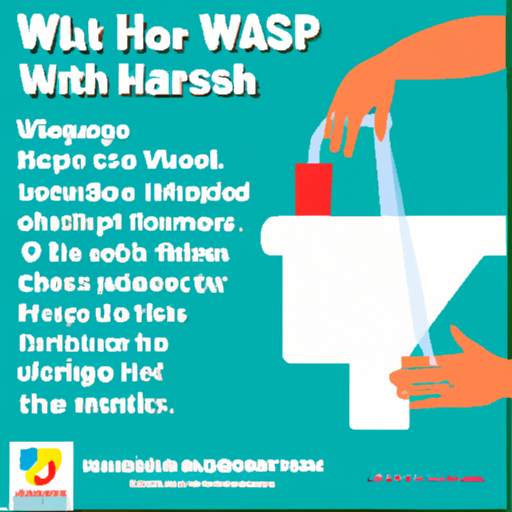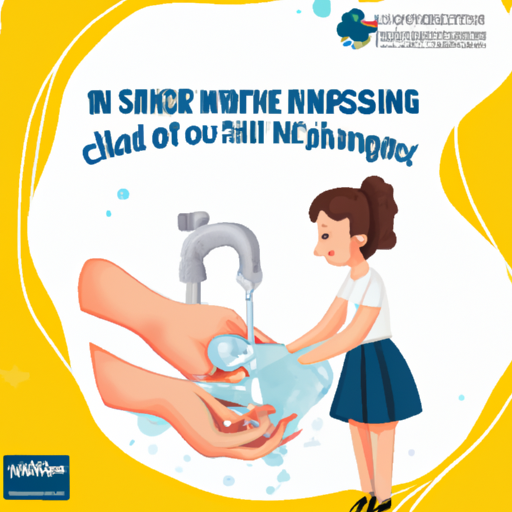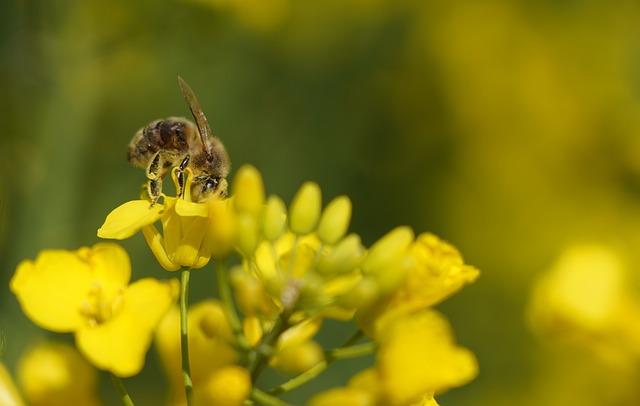
Do you ever wonder if you’re washing your hands properly with soap and water? It’s an essential skill that many of us have been taught since we were children, but it’s always good to double-check and make sure we’re doing it right. In this article, we’ll discuss the proper way to handwash with soap and water, so you can keep yourself and others safe from harmful germs and bacteria.
When it comes to handwashing, the process is actually quite simple. First, wet your hands with clean, running water. Then, apply enough soap to cover all surfaces of your hands. This includes the palms, backs of your hands, between your fingers, and under your nails. Don’t forget to rub your hands together vigorously for at least 20 seconds. This helps create friction that can effectively remove dirt and germs. Finally, rinse your hands well under running water and dry them thoroughly with a clean towel or air dryer.
By following these steps, you can be confident that you’re properly washing your hands with soap and water. In the next article, we’ll dive deeper into the importance of hand hygiene and the specific situations when handwashing is crucial. So, stay tuned and remember, clean hands lead to a healthier you!

Table of Contents
Introduction
Handwashing is a simple yet incredibly effective way to prevent the spread of infections and promote good hygiene. It is a practice that we should all prioritize, especially in the midst of a global pandemic like COVID-19. In this article, we will guide you on the proper technique for handwashing, discuss the importance of handwashing in preventing illness, and address common mistakes to avoid. Whether you are a healthcare professional, a parent, or simply someone who wants to take the necessary steps to protect yourself and those around you, this guide will provide you with all the information you need to properly handwash with soap and water.
Why Handwashing is Important
Prevention of illness
Regular handwashing is an essential part of maintaining good health. By washing your hands, you remove germs, bacteria, and viruses that may be on your skin. This, in turn, helps to prevent you from getting sick and reduces the risk of spreading illness to others. Many common illnesses, such as the flu or the common cold, can be prevented by practicing proper hand hygiene.
Reduction of the spread of infections
Handwashing is particularly important in healthcare settings, where patients are often more vulnerable to infections. Healthcare workers who regularly wash their hands greatly reduce the risk of transmitting infections from patient to patient. Similarly, in our everyday lives, practicing good hand hygiene can help break the chain of infection and protect those around us, especially those who are more susceptible, such as the elderly or individuals with weakened immune systems.
Promotion of good hygiene
Handwashing is not only crucial for preventing illness; it also plays a significant role in promoting overall hygiene. By making handwashing a regular habit, you are demonstrating a commitment to cleanliness and well-being. It sets a positive example for others and helps create a culture of hygiene consciousness in homes, workplaces, and communities.
The Proper Technique for Handwashing
To ensure that you are effectively removing germs from your hands, it is important to follow the proper handwashing technique. Here are the steps you should follow:
Wet your hands
Start by wetting your hands with clean, running water. The temperature of the water is a matter of personal preference, but it should be comfortably warm.
Apply soap
Next, apply a sufficient amount of soap to your hands. This can be either liquid soap or bar soap – both are effective in killing germs.
Lather your hands
Rub your hands together, creating a lather. Be sure to cover all parts of your hands, including the palms, backs, fingers, and nails. The friction created by rubbing your hands together helps to loosen and remove dirt, germs, and oils.
Scrub thoroughly
Continue to scrub your hands for at least 20 seconds. Singing the “Happy Birthday” song twice can help ensure that you are washing for the recommended duration. Pay particular attention to the areas between your fingers, the backs of your hands, and under your nails.
Pay attention to the important areas
Certain areas of your hands are more prone to harboring germs, so pay extra attention to these areas. These include your fingertips, thumbs, and the area around your wrists. Thoroughly scrubbing these areas will help ensure a more effective handwashing.
Rinse your hands
Rinse your hands thoroughly under clean, running water. Make sure to remove all soap and lather from your hands. Leaving soap residue on your skin can cause irritation, especially if you have sensitive skin.
Dry your hands properly
After rinsing, use a clean towel or air dry your hands. It is crucial to dry your hands thoroughly, as wet hands can easily transfer germs. If using a towel, ensure it is clean and used solely for drying hands. Additionally, drying your hands properly can help prevent cracked skin, which can be an entry point for germs.
The Duration of Handwashing
The recommended time for handwashing
As mentioned earlier, the recommended duration for handwashing is at least 20 seconds. This may seem longer than what you are used to, but it is crucial for ensuring effective removal of germs.
Factors that influence the duration
Several factors may influence the duration of handwashing, including the level of dirt or grime on your hands and the type of activity you were engaged in. For example, if your hands are visibly dirty or you have been handling chemicals, it may be necessary to wash for longer than 20 seconds to ensure proper cleanliness.

Choosing the Right Soap
Use liquid soap or bar soap
When it comes to choosing soap for handwashing, both liquid soap and bar soap are effective options. The choice ultimately comes down to personal preference. However, it is important to note that liquid soap is often more hygienic, as it is less likely to be contaminated by multiple users.
Consider the ingredients
When selecting soap, it is essential to consider the ingredients. Look for soap that contains antibacterial properties, as this will help kill harmful germs. Additionally, consider any allergies or skin sensitivities you may have and choose soap accordingly.
Check for antimicrobial qualities
Some soaps may have antimicrobial qualities, meaning they can target a broader range of germs. This can be especially beneficial in healthcare settings or during disease outbreaks, such as the COVID-19 pandemic. However, it is important to note that regular soap is still effective for everyday handwashing and should not be dismissed as less adequate.
Proper Handwashing for Different Situations
Handwashing is important in various situations to ensure proper hygiene and reduce the risk of illness. Let’s explore some specific scenarios where handwashing is crucial:
Handwashing before preparing food
Before handling any food, it is essential to wash your hands thoroughly. This helps remove any harmful bacteria that may have accumulated on your hands, reducing the risk of foodborne illnesses.
Handwashing before and after using the bathroom
Washing your hands before and after using the bathroom is an essential hygiene practice. By doing so, you eliminate any germs that may have been picked up while using the facilities and reduce the risk of contaminating yourself or others.
Handwashing after coughing, sneezing, or blowing your nose
Respiratory droplets can contain viruses and bacteria that may be easily transferred to your hands. It is important to wash your hands thoroughly after coughing, sneezing, or blowing your nose to prevent the spread of illness.
Handwashing after touching animals or waste
Animals, including household pets, can sometimes carry harmful bacteria or germs. Additionally, waste materials, such as cleaning up after a pet or taking out the garbage, can introduce germs to your hands. Washing your hands after these activities is crucial to maintain proper hygiene.
Handwashing after handling garbage or cleaning
Garbage and cleaning materials can be a breeding ground for bacteria, making it essential to wash your hands after handling these items. Proper hand hygiene in these situations helps prevent the spread of germs and maintains a clean environment.
Common Handwashing Mistakes to Avoid
While handwashing is a simple practice, it is important to avoid common mistakes that can compromise its effectiveness. Here are some common mistakes to avoid:
Not washing for long enough
Many people do not wash their hands for the recommended 20 seconds. It is crucial to ensure you scrub your hands for the recommended duration to achieve proper cleanliness and remove germs effectively.
Not using enough soap
Using an adequate amount of soap is essential to create a good lather and ensure effective removal of germs. Be sure to use enough soap to cover all parts of your hands and create friction while scrubbing.
Not rinsing properly
Improper rinsing can leave soap residue on your hands, which can lead to irritation and dryness. Be thorough when rinsing, making sure to remove all soap and lather from your hands.
Not drying hands completely
Drying your hands properly is just as important as washing them. Leaving your hands wet can promote the growth of bacteria and transfer germs easily. Take the time to dry your hands thoroughly using a clean towel or air drying.
Not washing hands frequently enough
Handwashing should be a regular part of your daily routine, not just an occasional practice. Washing your hands frequently, especially during times when germs may be more prevalent, such as during cold and flu seasons, is crucial to prevent the spread of illness.
Handwashing and the COVID-19 Pandemic
The importance of handwashing in preventing COVID-19
Handwashing is one of the most effective measures to prevent the spread of COVID-19. The virus is primarily transmitted through respiratory droplets and can easily be transferred to surfaces, including our hands. By washing our hands regularly, especially before touching our faces, we can reduce the risk of infection and transmission.
Effective handwashing techniques to prevent transmission
To effectively prevent the transmission of COVID-19, it is important to follow proper handwashing techniques. Regularly wash your hands with soap and water for at least 20 seconds, especially after being in public spaces, using public transportation, or touching commonly shared surfaces. Hand sanitizers with at least 60% alcohol content can also be used when soap and water are not readily available.
Handwashing with Soap and Water vs Hand Sanitizers
The advantages of handwashing with soap and water
Handwashing with soap and water is generally considered the gold standard for hand hygiene. Soap not only helps remove dirt and germs from the skin’s surface but also helps break down the outer layer of certain viruses, rendering them inactive. Additionally, handwashing physically removes pathogens from your hands, reducing their presence more effectively than hand sanitizers.
The effectiveness of hand sanitizers
Hand sanitizers are a convenient alternative to handwashing when soap and water are not readily available. They are particularly useful in situations where handwashing facilities are limited, such as when traveling or in public spaces. However, it is important to note that hand sanitizers are not effective against all types of germs and may be less effective when hands are visibly dirty or greasy.
Situation-specific considerations
While hand sanitizers can provide a quick and effective way to clean your hands, handwashing with soap and water should always be the preferred method when possible. However, it is important to consider the situation and use the appropriate method accordingly. In healthcare settings or during public health emergencies, following the guidance of healthcare professionals and public health authorities is crucial.
Conclusion
Proper handwashing with soap and water is a simple yet powerful practice that can prevent illness, reduce the spread of infections, and promote good hygiene. By following the recommended techniques and making handwashing a regular part of our daily routine, we can protect ourselves and those around us. Whether in healthcare settings, our homes, or public spaces, let us prioritize hand hygiene to maintain a healthier and safer future for all.







